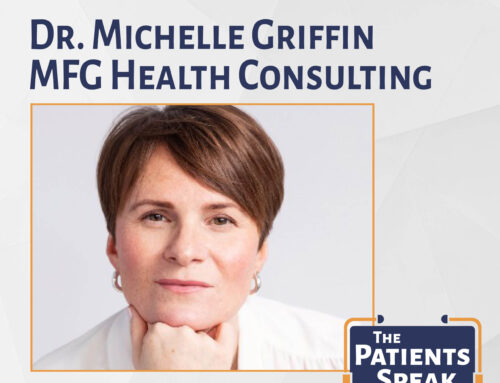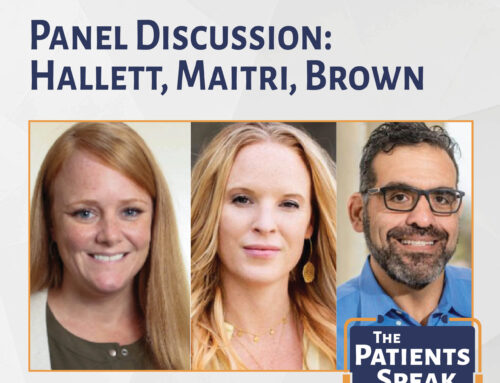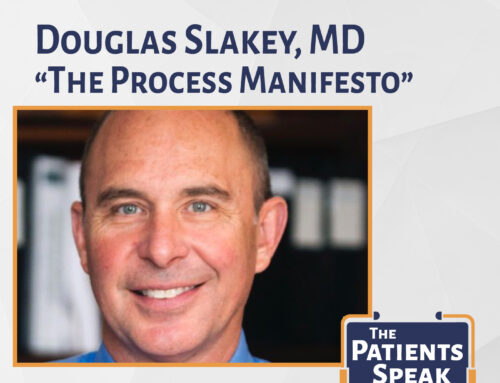It’s been a great start to the podcast.
We’ve learned so much and have been inspired to accelerate the patient journey.
We’ve heard motivating words from healthcare leaders on the importance of listening to the patients speak.
When we reflect on just these four episodes, we get a sense of importance and the commitment of leaders to elevate patient listening to a new level.
Listening to patients starts in clinical development phase
Keli Walbert said,
“It really starts with us in development of our clinical trials. So we work very closely with advocacy organizations and we develop relationships with advocacy organizations in disease states well before we bring them to market. The reason that we do that is exactly as you exp just outlined. We want to get to know patients. We want to understand what their experience is, and we wanna give them the opportunity to actually inform our clinical trials so that we can develop trials and we can develop endpoints and we can develop data that is relevant and meaningful in the real world and relevant and meaningful to patients so that when we come to market, we’re talking about their disease states and we’re talking about our treatments in a way that is meaningful to.”
Why patient voice is so important – close gaps, improve access
Michael Biarnes emphasized,
“It’s our responsibility to help improve access for everyone, not just those who live next to you know, the big new shiny institution that has all of the great resources. And we need to engage those individuals in a way that will bring forth the right vo voices, that trusted advisors, the trusted community leaders to ensure that individuals know of the types of care that you know, can be achieved no matter where you are, no matter where you live, no matter what demographic you might have.
And you’re bringing up some of these health gaps, these disparities. And we, again, we we’re focused a lot these days on diversity and equity and inclusion, especially in clinical trial recruitment. What, what are some of the things that you’re seeing that are helping the recruiters of clinical trials improve their reach, you know, be more inclusive, improve that diversity?
So a lot of it is this engagement with broader communities trying to, trying to understand the stakeholders who are truly, um, leaders to a, a given community, to a given population, right? People who are trusted advisors and building those relationships. And it takes time and it takes effort. It, it’s not just a simple, you know, marketing campaign. It this means face to face interactions, dealing with key opinion leaders and, and making sure that, you know, you’re not just talking about a product, you’re talking about education, right? So disease, state awareness, understanding the patient journey and bringing, as you said, pain points, but making it, making it known that these issues are not just theirs. That these are shared experiences and that we’re trying to listen and we’re trying to make improvements. And, and so it goes to a lot of this patient education early and often and, and just trying to get as much engagement with the key stakeholders as possible.”
Other creative ways to incorporate patient voice
Shefali Shah shared how her company MindMaze builds the patient’s voice into the system
“That is so critical. we really live the patient journey, um, in a number of different ways. So first and foremost, um, we have patients who have survived stroke, um, or other traumatic brain, uh, injuries. And our on the product team, they are in there developing the product. So right from the very base we have, um, you know, patients kind of bringing in their experience into the fabric of the product. Um, the other thing that we are very proud of is also bringing, uh, therapists into the product design process. And, uh, you know, these are therapists who have seen hundreds and thousands of patients across their lifetime and they understand at a more macro level, what are some of the con the commonalities and what are some of the biggest challenges that patients face. Uh, even though as you know, every patient is going to present themselves quite differently, but yet there are some universal factors that we are able to take into consideration.
We do so much more. We are, uh, you know, looking at patient research. We are also, um, you know, I personally listen to podcasts, uh, to really understand the patient journey. And, uh, you know, I do have to give a shout out to a very lovely podcast called Recovery After Stroke. And they have done an amazing job of just talking to patients and caregivers. Um, and, and I think listening to those stories unfiltered without saying, Hey, this is for market research purposes, is such a fantastic way of integrating their stories and their experiences.”
Keeping the internal team focused on the patient
Mark asked Matt Mitcho, “there’s a lot of other, uh, executives and managers in, in your seat listening to our show who say, We just got to keep our people, our company, you know, our reps, our educators, grounded in the patient voice. What, what else are you doing to stay? You mentioned a conference, for example. What else are you doing to keep your, your team indoctrinated with the patient voice?”
Matt said, “I appreciate that question very much because I think there’s a lot of in inauthentic leadership in the world. And that’s where I’m going, Mark. So, you know, saying it, doing it are two different things. I can tell you I’m a great guy, but if my behavior does not show that I am somebody that puts other people first, then it’s hard to believe that. And that’s what we, that’s what we try to do by being patient-centric. Not saying it on every piece of collateral, but making sure that the culture that we’ve created within the organization focuses on the patient, focuses on getting the patient an answer, focuses on the parts that we can control, white-glove service, accurate results — we do not have the luxury of missing. Every time we run a test, it’s somebody that is waiting on the other end to get a very specific, very accurate answer. So that they can do something to make themselves feel better or work with their clinician to make themselves feel better.
Subscribe now so you won’t miss an upcoming episode.
If you would like to read more about 83bar and the patient activation system, go to 83bar.com





